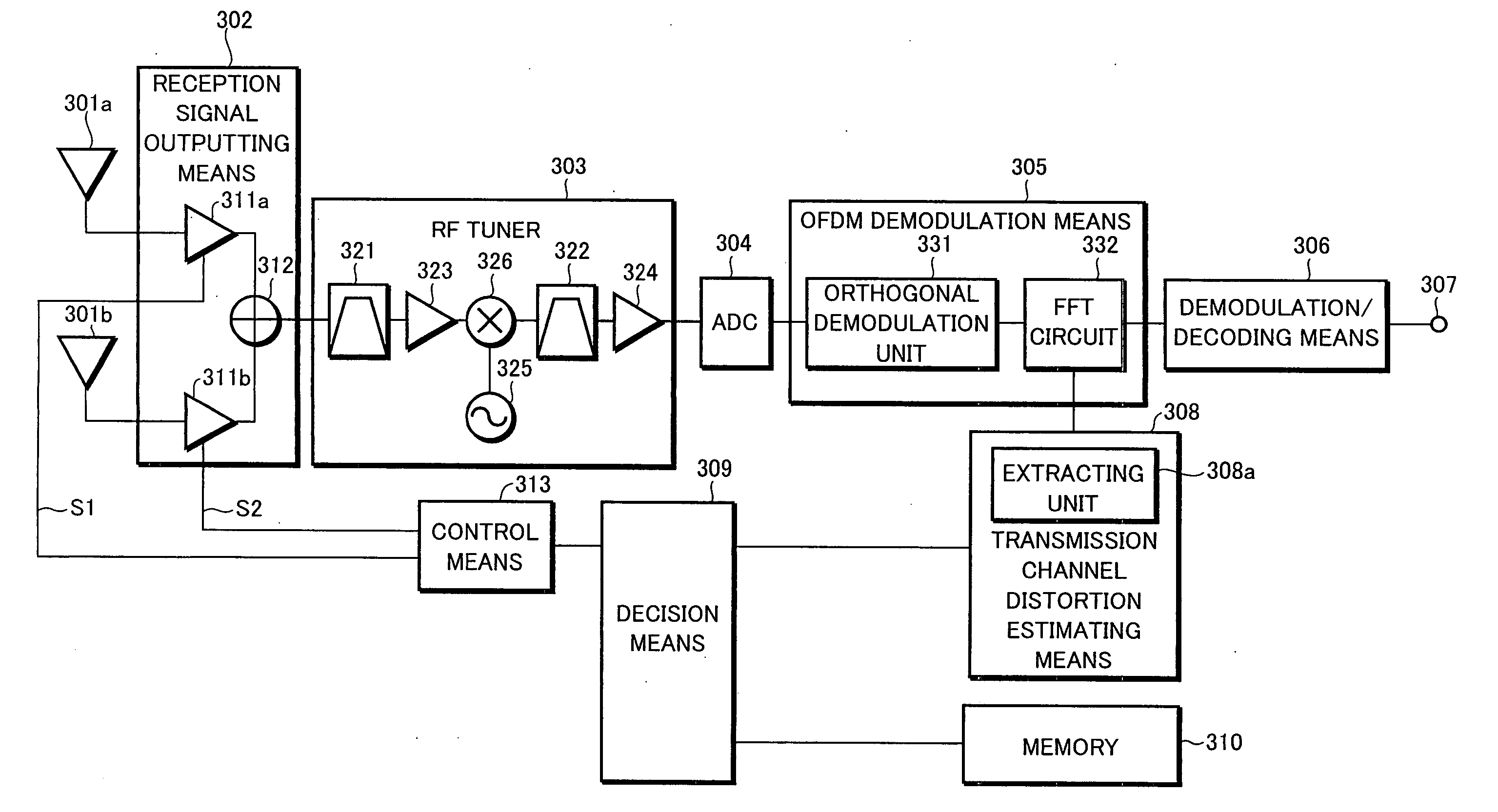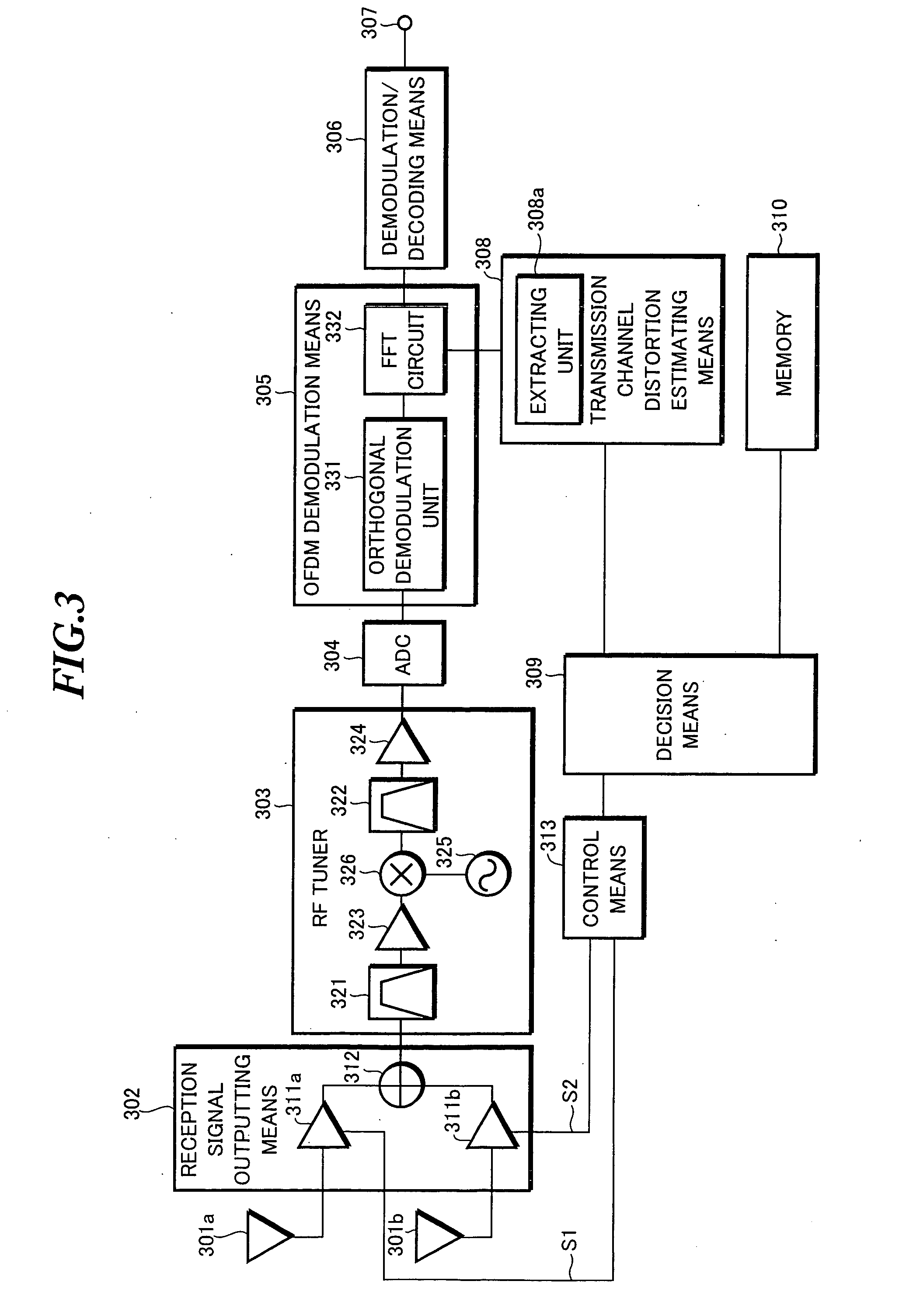Receiver, receiving method, reception controlling program, and recording medium
a technology of receiving method and recording medium, applied in the direction of multiplex communication, orthogonal multiplex, polarisation/directional diversity, etc., can solve problems such as errors in demodulation
- Summary
- Abstract
- Description
- Claims
- Application Information
AI Technical Summary
Benefits of technology
Problems solved by technology
Method used
Image
Examples
first embodiment
[0026] Now, a first embodiment of this invention will be described. FIG. 3 is a block diagram showing the general configuration of a receiver according to the first embodiment.
[0027] The transmission signal under the OFDM transmission scheme is received by a plurality of antennas 301a and 301b. For diversity reception, the number of antennas is at least two. Reception signal outputting means 302 selects the transmission signal received by the antenna 301a or 301b which is selected based on select signals S1 and S2 of decision mean 309, and outputs the same to an RF tuner 303. This reception signal outputting means 302 comprises AGC amplifiers 311a and 311b, and an adding unit 312. The gain of the AGC amplifier 311a or 311b which is provided for the antenna 301a or 301b unselected by the select signals S1 and S2 is lowered to interrupt the input, or to decrease the proportion in the combining ratio of the transmission signals in the adding unit 312. The reception signal output means...
example 1
[0034] The memory 310 according to an example 1 contains a reference value for an SP carrier power difference of the pilot signals SP to be compared with. This SP carrier power difference is the differential power H−L between the pilot signals H of higher power and the pilot signals L of lower power among the pilot signals SP of the respective frequencies shown in FIG. 4. In the shown example, the group of pilot signals H of higher power include SP1-SP3 and SP7-SPn. The group of pilot signals L of lower power include SP4-SP6.
[0035] The decision means 309 compares the differences between the frequency-specific powers of the pilot signals extracted by the transmission channel distortion estimating means 308 and the reference value stored in the memory 310. If the differences between the frequency-specific powers of the pilot signals exceed the reference value, or threshold, the resulting decision to switch the antennas 301a and 301b selectively is output to the control means 313. The...
example 2
[0046] An example 2 provides a configuration in which the processing of the example 1 described above is performed in units of a plurality of symbols. FIG. 7 is a flowchart for explaining the operation of changing the receiving condition according to the example 2. As employed in the processing shown in FIG. 7, the parameter n represents the number of symbols of the pilot signals SP to be used for deciding on the operation of changing the receiving condition. The parameter m represents the number of symbols of the pilot signals SP stored in the memory 310. This m has an initial value of zero.
[0047] When a transmission signal is received, the individual components shown in FIG. 3 perform signal processing on this transmission signal. A signal is thus demodulated by the FFT circuit 332 of the OFDM demodulation means 305. The extracting unit 308a extracts a pilot signal SP from the signal demodulated by the OFDM demodulation means 305 (step S701). Next, the extracted pilot signal SP i...
PUM
 Login to View More
Login to View More Abstract
Description
Claims
Application Information
 Login to View More
Login to View More - R&D
- Intellectual Property
- Life Sciences
- Materials
- Tech Scout
- Unparalleled Data Quality
- Higher Quality Content
- 60% Fewer Hallucinations
Browse by: Latest US Patents, China's latest patents, Technical Efficacy Thesaurus, Application Domain, Technology Topic, Popular Technical Reports.
© 2025 PatSnap. All rights reserved.Legal|Privacy policy|Modern Slavery Act Transparency Statement|Sitemap|About US| Contact US: help@patsnap.com



